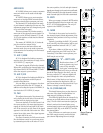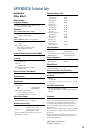
22
16.1" (410 mm)
4.1" (105 mm)
14.4" (365 mm)
DFX•12
WEIGHT
10.0 lbs.
(4.5 kg)
DFX•6
WEIGHT
8 lbs.
(3.6 kg)
11.8" (300 mm)
14.4" (365 mm)
The majority of AC outlets encountered in
homes and clubs (in the U.S.) are served by a
240 VAC center-tapped service entrance trans-
former. This provides two phases of AC power
on either side of the center tap, at 120 V each.
If lighting is used in a show, it is preferable
to power the lights from one leg of the service,
and power the audio equipment from the
other leg. This will help minimize noise from
the lights coupling into the audio (particularly
if SCRs, or light-dimmer switches, are used).
In order to minimize ground loops, the
safety grounds for all the outlets should be
connected to a common (“star”) grounding
point, and the distance between the outlets
and the common grounding point should be as
short as possible.
When setting up for a show, oftentimes you
are plugging into an AC power distribution sys-
tem you know nothing about. You may even be
faced with 2-wire outlets that are missing the
third safety ground pin. It’s a good idea to have
a three-wire AC outlet tester in your toolbox so
you can check the outlets yourself to make
sure they are wired correctly. These testers
will tell you if the polarity of the hot and neu-
tral wires is reversed and if the safety ground
is disconnected. Don’t use an outlet if it is
wired improperly! This is to protect yourself as
well as your equipment.
If you find that you must plug into a two-
wire outlet, you will need to use a two-wire to
three-wire adapter (cheater plug). These
come with a metal tab that you put under-
neath the center screw that holds the AC
outlet faceplate in place. This center screw
must be grounded. You can check it by con-
necting the adapter to the outlet and then
plugging in your handy-dandy AC outlet tester.
NEVER bypass the AC plug’s
ground pin. This is
dangerous!
AC Power Considerations
Dimensions


















